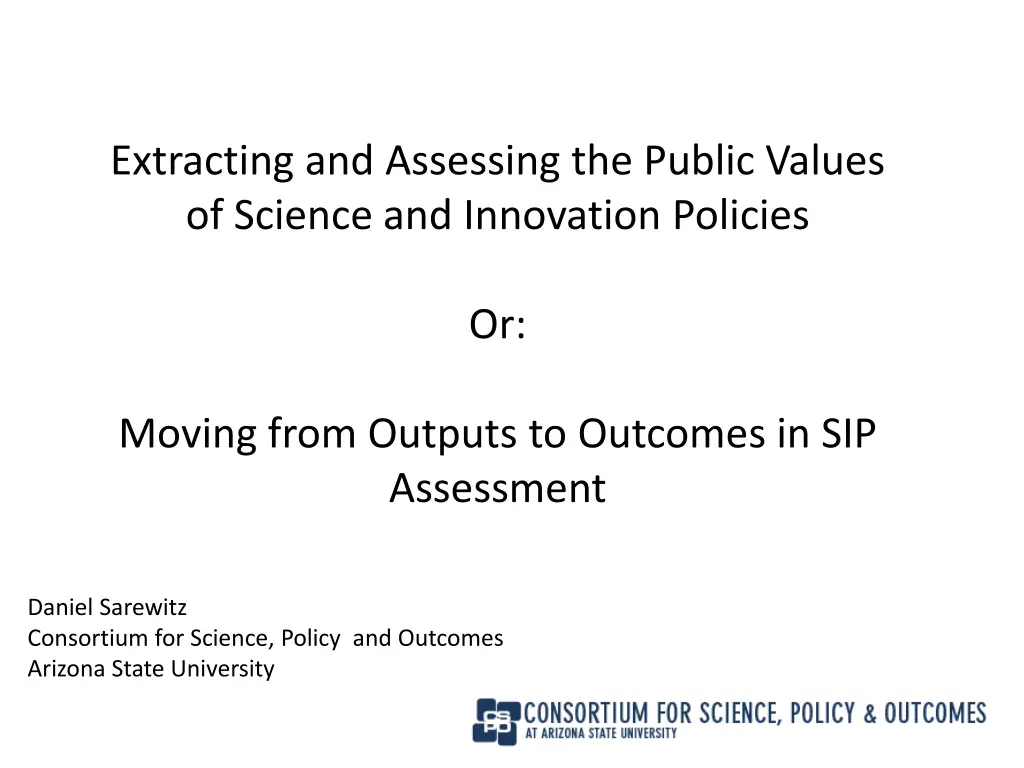
Assessing Public Values in Science and Innovation Policy
Explore the importance of public values in science and innovation policy assessment. Discover how traditional models are enhanced with Public Value Mapping to avoid value failures. Learn about the methods used for policy analysis and societal impact assessment in achieving desired public values.
Download Presentation

Please find below an Image/Link to download the presentation.
The content on the website is provided AS IS for your information and personal use only. It may not be sold, licensed, or shared on other websites without obtaining consent from the author. If you encounter any issues during the download, it is possible that the publisher has removed the file from their server.
You are allowed to download the files provided on this website for personal or commercial use, subject to the condition that they are used lawfully. All files are the property of their respective owners.
The content on the website is provided AS IS for your information and personal use only. It may not be sold, licensed, or shared on other websites without obtaining consent from the author.
E N D
Presentation Transcript
Extracting and Assessing the Public Values of Science and Innovation Policies Or: Moving from Outputs to Outcomes in SIP Assessment Daniel Sarewitz Consortium for Science, Policy and Outcomes Arizona State University
Output Corn Productivity
Given all the complexity, for any program(me) we can still ask: What public values are sought? Are the strategies for linking institutions, network actors, and individuals viable? Is the causal logic sound? Are the human and institutional resources in place? Source: Bozeman, 2002
Public Values in SIPs: Broadly Shared Values that Justify Public Investments in S&T and Express the Implicit Links Between Those Investments and Desired Social Outcomes Increase quality and years of healthy life. Eliminate health disparities. (US Health and Human Services Department) Ensure a safe and affordable food supply. (US Agriculture Department) Foster a reliable energy system that is environmentally and economically sustainable. (US Energy Department)
Public Values Do Not Equal Scientists Values Perceived Risks: 2007 Scientist and Public Opinion Surveys (Corley and Scheufele)
Method: Public Value Mapping Traditional Science Policy Logic Model Enhanced Science Policy Logic Model Adds PVM to Avoid Public Values Failure Research Activities, Institutions, and Translation Assertions of Public Value Priorities and Societal Benefits, Risk, and Impacts Policy Analysis using Standard Market-based Assessment or Output Assessment Approach Public Value Mapping (Non-Economic Analysis) Case Study Approach Summarize case background and identify stakeholders Secure stakeholder documents including policy statements, plans, memos, web pages Public value statement scan Value chain analysis (links and hierarchies) Assessment of institutional capacities Identify potential values failures (individual value failures and chain failures) And then a miracle occurs Retrospective or Prospective Analysis of Capacities to Achieve Stipulated Public Values Societal Impact
Public Value Mapping: Public Failure Criteria Failure Definition Example Public Failure Criterion 1. Mechanism for values articulation and aggregation Political process and social cohesion insufficient Peer review 2. Imperfect monopolies Private provision permitted yet government monopoly in the public interest Clinical trials 3. Scarcity of providers Recognition of public value and agreement on public provision but unavailability of providers Landsat 4. Short time horizons Longer term view shows short term actions counter to public value Energy R&D 5. Substitutability vs. conservation of resources No satisfactory substitute Wetlands protection or sale of human organs 6. Benefit hoarding Commodities or service captured, limiting distribution to the population Terminator gene
Useful Information PUBLIC VALUES IN CLIMATE SCIENCE High Quality Science Coordination and Collaboration (R. MEYER, 2011) Transparency and Communication Stakeholder Participation
Case: U.S. climate change research (Meyer 2011) Explanation Public Failure Criterion CCSP criteria for prioritization are too broad and vague; no connection between priorities, outcomes or values. Stakeholders widely or ambiguously defined 1. Mechanism for values articulation and aggregation 2. Imperfect monopolies Priorities tend to favor natural science over social science, and science-driven research over needs-oriented research despite recognized needs 3. Scarcity of providers 4. Short time horizons 5. Substitutability vs. conservation of resources 6. Benefit hoarding
Case: university patenting (Valdivia 2011) Explanation Public Failure Criterion Opposition to Bayh-Dole was neutralized by ill-designed safeguards that were easily defused and struck down 1. Mechanism for values articulation and aggregation Failure to enforce march-in rights for controlling excess of monopolistic pricing Failure to support universities balancing organizational needs and the public interest 2. Imperfect monopolies 3. Scarcity of providers 4. Short time horizons 5. Substitutability vs. conservation of resources 6. Benefit hoarding
Case: nanomedicine (Slade 2011) Explanation Public Failure Criterion No consistent or effective policy/strategy to increase minority participation in clinical trials. 1. Mechanism for values articulation and aggregation 2. Imperfect monopolies Only 3% to 4% of board-certified minority physicians participate in clinical trials. 3. Scarcity of providers 4. Short time horizons 5. Substitutability vs. conservation of resources Lack of diversity in study populations results in inequitable distribution of clinical trials (often life-saving) resources. Most trials limit co-morbid conditions prevalent in minority populations. 6. Benefit hoarding
SIP Policies Matter for Public Values Public Failure AIDS Research Market Failure Market Success Earthquake Research Public Success
Public Value Mapping: Watch the Video!! http://www.cspo.org/scisip/movies/ Starring pvm video.tiff as Public Values As The Market Failure Model
Collaborators and Co-Conspirators: Barry Bozeman, University of Georgia Cathy Slade, University of Georgia Ryan Meyer, California Ocean Science Trust Genevieve Maricle, USAID Nat Logar, Harvard Walter Valdivia, Brookings Institute Erik Fisher, ASU See: Minerva 2011, v. 49 (1).
